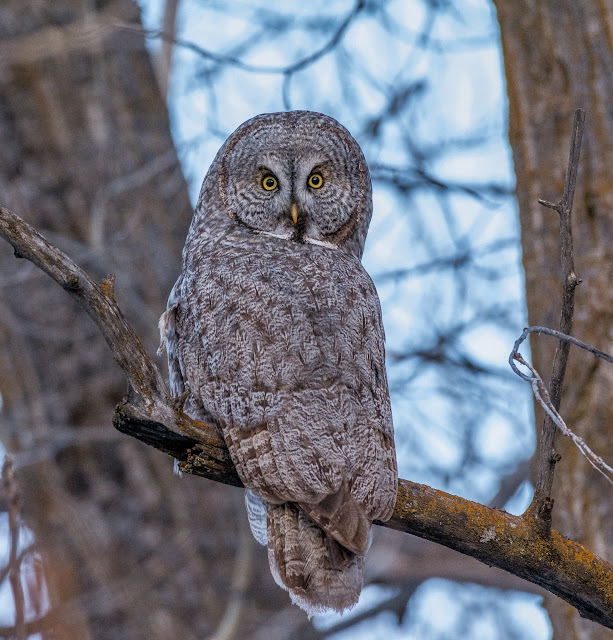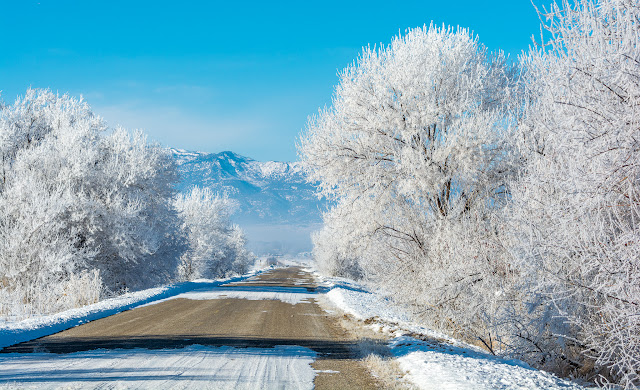
After hearing and seeing a few Black-capped Chickadees pass through the woods in front of us I decided to capture a few images to test my lens and camera settings. The Chickadees were not quite the size we were looking for, but they were fun little birds to photograph.
We decided to move our Great Gray search over to the Jackson, Wyoming for the afternoon hours. We saw a number of raptors perched on power poles along the roads we traveled. One Rough-legged Hawk was accommodating. The low-light conditions caused the images of the hawk to look almost like a painting.
It's a simple image, but I loved seeing the under side field marks of a soaring Rough-legged Hawk as it made lazy circles in the sky above us. Since this species nests in the northwest parts of Canada and Alaska it is a winter privilege to see them in the western states of the US.
The Wyoming search came up empty in terms of Great Grays as well, but we enjoyed some other birds and wildlife during our search. Several distant adult Bald Eagles were intermittently perching on poles and flying over a field at one point. The images are heavily cropped in order to make them appear a bit closer.
Mammals took a brief priority over birds when a distant and lone coyote crossed a field on its way to a wooded area we had planned to include in our Great Gray search.
As we were leaving our Wyoming search area we came across a male Belted Kingfisher that was perch hunting from a power line near a bridge we crossed. The kingfisher would occasionally fly down to the water to attempt to catch some small fish.
We were under dark skies again as we were leaving the Jackson area, but we stopped and looked back to capture some images of the Teton Mountains before heading back over to the Idaho side.
Back in Idaho and with the Grand Tetons on the eastern horizon we began the last search of day one for our elusive owls. The shadows of the trees were growing longer so the day was fading quickly.
From a distance the silhouette of a large bulky bird gave us hope. However, we soon recognized that large bird as an adult Bald Eagle as we drove closer. The eagle was facing the setting sun on the far side of a large deciduous tree. I tried for a few minutes to find a perspective from which I had a clear view of the eagle. It turned out that all but the one angle below were obscured with a tangle of branches. I like how the rays from the setting sun highlighted the eagle's eye.
The look from the eagle in this deeply cropped image is piercing. I was surprised to see how much detail actually remained after cropping the image so much. The capabilities of today's digital cameras, lenses, and processing software is impressive.
Further down the road was a Eurasian Collared-Dove that seemed curious about what we were doing.
The sun was still above the horizon when we encountered our first owls of the trip. We heard the hooting of Great Horned Owls and soon located a couple of them.
The owl below actually landed in the top section of a tree just where the last rays of sunlight were illuminating the tree. The lower parts of the tree were in the shadows so I actually said thanks when I realized what a great place the owl had picked.
We remained on the road below as owls called back and forth to each other. We believe we encountered two separate pairs of Great Horned Owls. One owl unexpectedly flew over my head. I pulled up the lens to focus and release the shutter as quickly as I could. Lighting and zoom were inadequate. I clipped the wings from the frame, but I was able to lighten the image to show the details. You can see the last bit of sunlight illuminating the soft belly and wing pit feathers as the owl flew away from the sun.
Eric captured this image with his phone. You already know I'm the crazy guy in the road, but you may have to look twice to see the Great Horned Owl at the very top of the tree. Believe it or not, I was more comfortable on my back than I was cranking my neck.
Just as we were about to call it a day, Eric spotted our first Great Gray Owl. It was way down the road, perched on a power pole right next to where we had parked my truck. The sun had set and the light was dimming quickly so we made our way toward the owl as quickly as we could without causing it to flush. We reached the truck and used it as a blind to get closer. A few vehicles passed and the owl flew over to a branch on the other side of the shaded road.
Day 2
After spending the night in a local lodge we set out early Saturday morning and searched a new location for Great Grays. It didn't take long on day two to encounter four separate Great Gray Owls. Two of those individuals are shown below.
I captured short video clips of two owls and uploaded them to my YouTube channel. Once again I was hand holding the big lens fully zoomed without the aid of a tripod or monopod so it's a little shaky, but I'm always impressed with the range of motion these owls enjoy with their heads and necks. I saved the video to play best at 1080p HD so be sure to use that or your best HD setting for the best resolution.
Satisfied with our Great Gray encounters we turned our focus to some smaller birds and entertained ourselves by photographing White-breasted Nuthatches and a Downy Woodpecker.
A last-minute decision to take a turn down "one more" road before heading home resulted in a few minutes of watching and photographing a weasel in its winter coat.
The drive was long and the visit was short, but the experiences made it all worthwhile. It was a trip to places new to me and I was once again impressed with the variety of wildlife and scenery our world has to offer. I can't wait for my next adventure into our great outdoors. I love people and nature and the places they meet.





































































